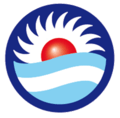Broad Front (Argentina)
Broad Front Frente Grande | |
|---|---|
 | |
| President | Adriana Puiggrós[1] |
| Founded | April 27, 1993 |
| Youth wing | Juventud Nacional del Frente Grande |
| Membership |
|
| Ideology | Kirchnerism |
| Political position | Centre-left to Left-wing |
| National affiliation | Front for Victory |
| International affiliation | Foro de São Paulo |
| Slogan | Otro país esta en Marcha (A different country is on the way) |
| Election symbol | |
 | |
| Website | |
| www.frentegrande.ar | |
The Broad Front (Spanish: Frente Grande) is a left-wing political party in Argentina most prominent in the 1990s.
The party was set up by a group of left-wing Justicialist Party members of the Argentine Chamber of Deputies, most notably Carlos Álvarez, and other left-wingers who were annoyed at the neo-liberal policies of President Carlos Menem, including dissident Christian Democrats led by Carlos Auyero and also figures such as Graciela Fernández Meijide. In 1990 the rebel Justicialists, having formed FredeJuSo, came together with the Communist Party of Argentina and others in a loose coalition. Álvarez proposed forming a unified party and dissolving the constituent members, thus automatically excluding the Communists, who left.
In May 1993 they joined with Frente del Sur, a party set up by film-maker Pino Solanas, to form the Frente Grande. In the 1993 elections, the party's list in the city of Buenos Aires gained 38% of the vote and several deputies were elected around the country, including Álvarez, Meijide and Solanas. Solanas left the party a short while later over personal differences.
In spring 1994, Álvarez led the Frente Grande into a new alliance, creating the Front for a Country in Solidarity (FrePaSo). FrePaSo would continue the success of the Frente Grande and propel Álvarez to be vice-president of the country. The Frente Grande continued to be a force in Buenos Aires politics, but has become largely marginalised with the collapse of FrePaSo; its members have largely joined the new Support for an Egalitarian Republic (ARI) party or returned to the Peronists under centre-left Presidents Néstor Kirchner and his wife and successor Cristina Fernández de Kirchner.
What remained of the Front swung behind the Kirchners' ruling Front for Victory. At the 2005 legislative elections, however, some sections of the Front joined the Encuentro Amplio with other left-wing parties in Buenos Aires and Buenos Aires Province. The coalition did badly and lost its existing national representation. In 2007, members of the Front including María José Bongiorno were elected as part of the Front for Victory. Of its leading figures, Nilda Garré serves as Minister of Defense and party leader Eduardo Sigal is a junior official in the sub-secretariat of American Economic Integration and Mercosur.
In 2012, the party had 161,050 members, making it the third largest party nationwide.[3]
References
- ↑ "Adriana Puiggrós es la nueva Presidenta del Frente Grande". Frente Grande. 17 December 2011.
- ↑ Registro Nacional de Afiliados a los Partidos Políticos, Cámara Nacional Electoral
- ↑ Estadística de Afiliados, Primer Semestre 2012, Registro Nacional de Afiliados a los Partidos Políticos, Cámara Nacional Electoral. Archived January 18, 2013, at the Wayback Machine.